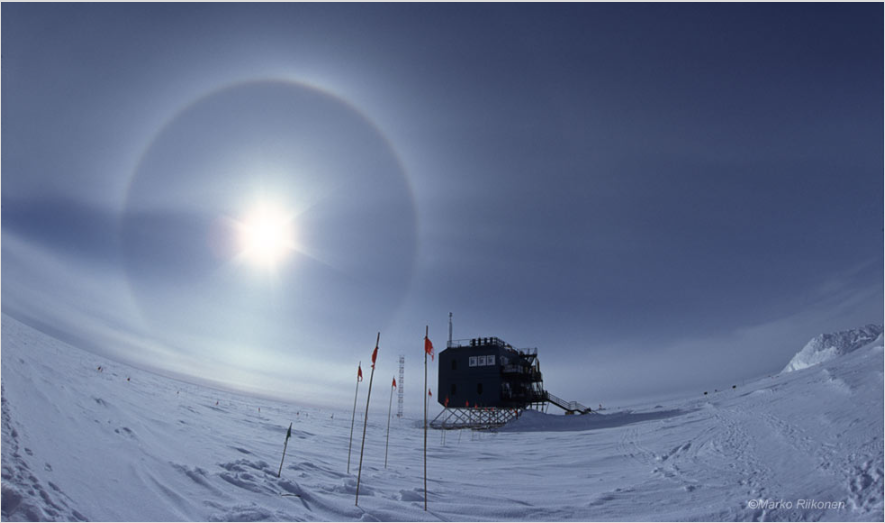22 degree halos
Exploring the Phenomenon of 22-Degree Halos
When it comes to atmospheric optics, one captivating phenomenon that often captures the attention of sky gazers is the 22-degree halo. This enchanting optical effect creates a ring of light around the Sun or Moon, appearing at an approximate distance of 22 degrees from these celestial bodies. While it may seem like a simple and common occurrence, the science behind this mesmerizing phenomenon is quite fascinating.
Understanding the Science behind 22-Degree Halos
The formation of 22-degree halos is attributed to the interaction of light with ice crystals suspended in the Earth's atmosphere. These hexagonal ice crystals act as miniature prisms, bending and refracting sunlight or moonlight as it passes through them. The specific angle of 22 degrees arises due to the refraction and reflection of light within these ice crystals.
Ice Crystal Characteristics
To understand the formation of 22-degree halos, it is important to delve into the characteristics of ice crystals. These crystals are typically hexagonal in shape, which influences the way light interacts with them. As light enters an ice crystal, it refracts, or bends, and then reflects off the inside surfaces before exiting. The angles at which the light enters and exits the crystal determine the size and shape of the resulting halo.
Halo Variations and Additional Phenomena
While the 22-degree halo is the most prominent and well-known, it is not the only halo that can be observed in the sky. Various other halos can form at different angles, including 46-degree circular halos, which are often fainter and less frequently seen. These additional halos are created by different angles of refraction and reflection within the ice crystals.
In some cases, when conditions are just right, additional optical phenomena can accompany 22-degree halos. One such phenomenon is known as an upper tangent arc, which can appear as a faint trace at the top of the halo. This arc is caused by sunlight or moonlight passing through horizontally oriented ice crystals. Additionally, in certain circumstances, the halo can appear to be more vibrant or have a thicker section due to variations in the ice crystal cloud's thickness.
Geographic and Seasonal Variations
The occurrence of 22-degree halos can vary depending on geographical location and the time of year. These halos are more commonly observed in regions closer to the poles, where ice crystal clouds are more prevalent. In polar regions, such as the South Pole, 22-degree halos can be observed with greater frequency and intensity. However, they can also occur in other latitudes under specific atmospheric conditions.
Moreover, the seasons play a role in the visibility of 22-degree halos. In colder climates, where ice crystal clouds are more likely to form, these halos tend to be more frequent during winter months. Conversely, in warmer regions, they may be less common.
Capturing the Beauty of 22-Degree Halos
Photographing 22-degree halos can be a rewarding endeavor for sky enthusiasts and photographers alike. To capture the full beauty of these optical wonders, it is important to consider a few key factors:
- Lighting Conditions: The ideal time to observe and photograph 22-degree halos is when the Sun or Moon is relatively low on the horizon. This angle creates a larger halo and enhances its visibility.
- Contrasting Background: Choosing a background with contrasting colors or textures can help highlight the halo in photographs.
- Camera Settings: Adjusting camera settings, such as exposure and white balance, can help capture the halo's intricate details and colors.
- Patience and Persistence: Given their dependence on specific atmospheric conditions, capturing 22-degree halos may require patience and persistence. Continuously monitoring the sky and being prepared to seize the moment can lead to remarkable photographs.
In conclusion, 22-degree halos are captivating atmospheric optical phenomena caused by the refraction and reflection of light within ice crystals. While the science behind these halos is intriguing, their beauty is best appreciated through personal observation or skillful photography. So, keep an eye on the sky, explore different locations, and embrace the wonder of these enchanting halos.

22-degree halo at the South Pole photographed by Marko Riikonen. The brightness at the halo top could be a trace of an upper tangent arc - or it could be where the ice crystal cloud thickens. Look carefully to the left to see a faint 46º circular halo. Image ©Marko Riikonen, shown with permission.
Note: this article has been automatically converted from the old site and may not appear as intended. You can find the original article here.
Reference Atmospheric Optics
If you use any of the definitions, information, or data presented on Atmospheric Optics, please copy the link or reference below to properly credit us as the reference source. Thank you!
-
<a href="https://atoptics.co.uk/blog/22-degree-halos/">22 degree halos</a>
-
"22 degree halos". Atmospheric Optics. Accessed on December 2, 2024. https://atoptics.co.uk/blog/22-degree-halos/.
-
"22 degree halos". Atmospheric Optics, https://atoptics.co.uk/blog/22-degree-halos/. Accessed 2 December, 2024
-
22 degree halos. Atmospheric Optics. Retrieved from https://atoptics.co.uk/blog/22-degree-halos/.